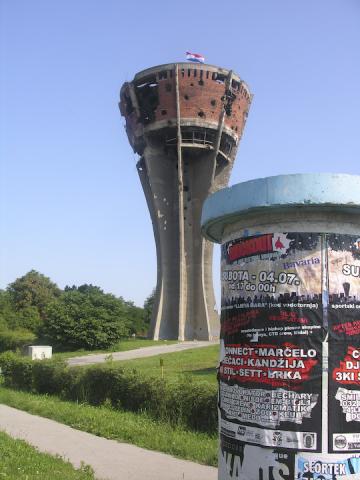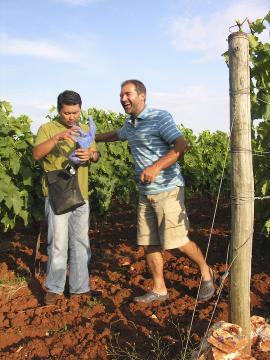101 Dalmatians
POSTED ON 04/09/2009The most poignant moment of a recent fact-finding wine trip to Croatia was the sight of a giant pock-marked water tower at Vukovar on the Danube on the drive back to Zagreb airport. The Croatian national flag was flying from its summit as a constant reminder of a not-so-distant turbulent period in the history of this beautiful country. It brought home one of the main reasons why Croatian wine remains the dark horse of Europe, for the time being at least. War in the Balkans followed by reconstruction, not to mention a huge domestic thirst for their own wines and relatively high prices, have prevented its wines from becoming better known outside its borders.
 blasted water tower at Vukova
blasted water tower at Vukova
It will have come as little surprise to the Croatians however that at the Decanter World Wine Awards this week their wines won more gold medals than more established rivals like New Zealand, Portugal, Argentina and California. They have, after all, been making delicious wine in the two decades since taking the quality route. Most if not all the gold-medal winning wines were sweet wines, repeating the success that Austria had a while ago. But that’s only half the story. Scratch beneath the surface and what becomes clear is that Croatia has a diverse indigenous wine culture whose dry whites and reds as well as its sparkling and sweet wines have the potential to add significantly to the flavour palette of the wine styles we enjoy in the UK.
Croatia is divided into two distinct wine regions, the Dalmatian coast on the Adriatic, and continental Croatia which juts into Serbia and Montenegro with Hungary to its north. Closest to Italy in Croatia’s north-west, the 80 kilometre-long heart-shaped peninsula of Istria with its stunningly beautiful expanse of Mediterranean coastline is home to refreshingly crisp, full-flavoured dry whites made from malvazija istarka. Like Galicia’s albariño, these wines have a special affinity with the local seafood. The Istrian vineyard was ten times its present size before World War 2 but systematically abandoned during the communist era. Moreno Coronica, one of Istria’s best producers, dates the start of the modern wine industry from 1992, when growers were allowed to bottle their own wines.
 Moreno Coronica giving journalist Simon Tam a piece of his red earth
Moreno Coronica giving journalist Simon Tam a piece of his red earth
Further down the Dalmatian coast, taking in the narrow strip of the Peljesac peninsula between Dubrovnik and Split and the stunning islands of Hvar, Brac, Lastovo and Vis, plavac mali is Croatia’s main red grape variety. Zinfandel was recently discovered to be one of its components, so it’s not surprising that plavac mali adapts well to the warmer southern Dalmatian coast. Here, grown as a bush vine on poor rocky soils, it’s capable of producing richly flavoured wines with aromas and flavours of dark fruits such as black cherry, plum and blackberry. Good native red varieties also include zlatina, pošip and babić.
Croatia’s other principal dry white grape variety is graševina, a Danubian grape variety much maligned as welschriesling, and blamed, usually justifiably, for boring wines like Lutomer laski riesling. Along with better-known grapes like chardonnay, riesling, pinot noir, pinot gris and merlot, it’s grown in the hillside vineyards of Kutjevo in continental Croatia, where it produces high quality dry aromatic whites full of juicy apple and citrus flavours. Is it too much to hope that before long we start to see a Tesco Finest Graševina, an Asda Extra Special Malvazija and a Sainsbury’s Taste the Difference Plavac Mali? For the full Croatian experience, see anthonyrosewine.com.
Something For the Weekend 5 September 2009
Under a Fiver
2008 Vino da Tavola Bianco.
Made from the southern Italian catarratto, trebbiano and moscato grapes by the roving French winemaker Gaetane Carron, this is a refreshingly crisp and zingy apple and pear dry Italian white of the everyday glugging variety. £3.99, Marks & Spencer
Under a Tenner
2007 El Malbec de Ricardo Santos, Las Madras Vineyard, Cuchillas de Lunlunta, Mendoza
This youthful juicy Argentinian malbec is full of the joys of supple blackberry and dark cherry fruitiness, a short period of aging in oak adding texture to its spicy qualities. £8.99, Majestic.
Splash Out
2005 Domaine de Roally Viré Clessé Tradition
White Burgundy so rich in complex flavours that the ripeness verges on the exotic, yet as you’d expect from the quality-conscious Thévenet family, this unoaked chardonnay maintains a wonderful freshness too. £17.99, buy 3 = £11.99, Wine Rack.
 I wish they all could be-ee Croatian....giiiiiiirrrrlllls: tour leaders Morana and Ivona
I wish they all could be-ee Croatian....giiiiiiirrrrlllls: tour leaders Morana and Ivona

